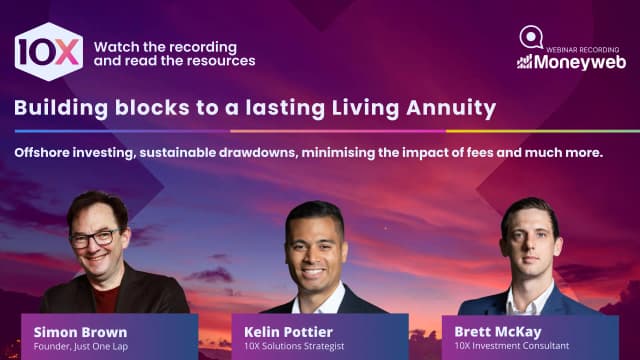Preservation fund investment strategy: Index tracking vs. active management
22 August 2025
The uncomfortable truth about retirement in South Africa - Rands and Sense by 10X [video]
We sit down with 10X Investment Consultant lead Andre Tuck and discuss the retirement savings crisis in South Africa. We also delve into living annuities, retirement annuities, TFSAs and everything in between. Read more
![The uncomfortable truth about retirement in South Africa - Rands and Sense by 10X [video]](/_next/image?url=https%3A%2F%2Fimages.ctfassets.net%2Fyqvz0zwovkbq%2F5ipSTnRq5Dp25fyghm5kGQ%2F02c801c78d5e1ca9280bfd34d7602368%2FAndre_Tuck_podcast_cover_image__1_.webp&w=828&q=75)
A key choice to make when managing your preservation fund is what your preferred investment strategy will be. Some investors may prefer to make use of index tracking funds, while other investors may prefer an active management strategy. This is an essential consideration, as it may affect the performance of your preservation fund, the fees that you pay on your preservation fund and overall long-term growth of your savings
As both strategies have their benefits, it’s important to take both sides into account, and make a decision that works best for you. In this article, we will delve deeper into both index tracking and active management as investment strategies to help you make an informed decision.
What is a preservation fund?
A preservation fund is a retirement savings vehicle where you can transfer your pension or provident savings when changing jobs, with no tax obligations. A preservation fund allows you to take advantage of potential compound growth over the long term. You will need to ensure that if you have a pension fund, this is transferred to a pension-preservation fund, whereas if you have a provident fund, it is transferred to a provident-preservation fund.
See your pension savings grow with our
Preservation Fund calculatorOnce your savings have been transferred across to your preservation fund, you an then select the underlying funds where the capital will be invested. Each fund has its own diversified asset allocation, and each is geared towards a different investment profile. The asset allocation of your investment is key, as it can play an important role in the growth of your capital over time.
This is even more important when it comes to preservation funds, as further contributions are not permitted, and you are relying on returns in order to grow your capital. As an investor, you need to consider whether you prefer an index tracking investment strategy or a more active investment strategy, each strategy coming with its own advantages.
Additionally, you should be aware of the new rules regarding withdrawals, as was implemented in September 2024 with The Two Pot Retirement System. All contributions will now be split between two ‘pots’, the ‘retirement pot’ and the ‘savings pot’, with two-thirds going to the retirement portion and one-third going to the savings portion. This will not be applicable to preservation funds, as there will not be any further contributions added. However, the savings component of the preservation fund will grow at the same rate as the total fund. If the total fund grows by double its size, both the savings pot and the vested pot will also grow by double the size.
There is also a third portion, which is called the ‘vested pot’. This refers to all contributions which were made prior to the implementation of The Pot Retirement System. This pot is governed by the old rules. These rules allow for one withdrawal from the vested pot prior to retirement.
See how the new system will impact your retirement savings
You can withdraw from your savings pot once per year for a minimum amount of R2000, but these withdrawals are taxed at your marginal tax rate, and an administration fee will apply. You are not able to withdraw from your retirement pot, as this is only accessible from retirement age, which is currently age 55 in South Africa. Please consult the latest FSCA guidance on the Two-Pot Retirement System.
Understanding Index tracking vs. active management
Index tracking involves the mimicking of a particular benchmark index, such as the S&P 500, in an effort to match the returns generated by the index. This investment strategy usually results in fewer costs involved, as there are fewer related activities such as research, analysis and trading costs.
An active strategy is where a fund manager chases the best returns and tries to ‘time’ the market. Included in this approach are more activities such as research, analysis and the buying and selling of securities. Due to the increased number of actively managed activities, you may see more costs involved, which may then be passed on to you, as the investor. You may also find higher fees being charged for the fund manager’s stock-picking expertise.
This approach may also not always produce the desired results, as data from the SPIVA Scorecards suggests, index tracking may outperform active management most of the time. According to the latest SPIVA South Africa Scorecard (as of 31 December 2024), 60.84% of South African actively managed equity funds underperformed the S&P South Africa DSW Capped Index over the ten years ending 31 December 2024. Active funds look to outperform, which may result in more volatility in performance compared to index tracking, which focuses more on consistency.
We've built the 'happy retirement' machine
Understanding the most effective strategy for investing your retirement savings is fundamental to experiencing a happy retirement. We've built an investment machine that gives you a great chance of really golden years. Read more

At 10X, we like to keep things simple, with a straightforward approach to our investment strategy. We make use of index tracking, which allows us to be more cost-effective with the fees that we charge. We also take a more active approach to asset allocation, always focusing on the long term to achieve the excellent returns that our clients deserve. To find out more about our investment strategy, follow this link.
The importance of the low fees of index tracking
Often, people overlook fees when it comes to retirement savings, but even the smallest difference can have a profound impact. Fees are, therefore, another important consideration when it comes to your preservation fund. High fees may have the potential to reduce the returns that you have available to reinvest and to grow over the long term. On the other hand, lower fees may mean there are more returns available to reinvest and potentially compound over time.

The usual fees that you may see charged on your preservation fund are as follows:
Management fees: These are fees charged for the management of the fund.
Administration fees: These are the fees charged for the administration of the fund. This will be for tasks related to reporting and tax.
Advisor fees: These are the fees charged by an advisor for the financial guidance provided. There is usually both an initial and an annual fee charged.
As mentioned above, index tracking tends to be the more cost-effective approach to preservation fund investments. The Effective Annual Cost (EAC) of an investment refers to the fees and costs associated with owning an investment over a one-year period of time. It is a standardised metric introduced by ASISA, allowing you, the investor, to assess and compare the fees that you are paying. You can then use this information to compare with the fees and costs associated with other service providers.
Compare your retirement investments
Effective annual cost calculatorAll factors being equal, a higher EAC will mean that there are fewer returns available to be reinvested and allowed to potentially grow and compound. A lower EAC, on the other hand, may mean that there are more returns available to be reinvested and potentially compounded over time. You can generally see your EAC on your investment statement. If not, you will be able to request your EAC from your service provider.
10X offers a useful EAC calculator as a part of our suite of free online tools. It allows you to see the costs and fees associated with 10X products, so you may compare them with other service providers with ease, allowing you to make an informed choice going forward. The EAC is just one factor to consider when comparing service providers.
Fee Example:
Let’s look at an example to show the effect of high fees on your preservation fund. We will compare fees of 3% with fees of 1%.
Let’s assume the following factors:
- Investment period of 30 years
- Investment of R200,000
- Return of 12% per annum
- An inflation rate of 6%
Example 1 (1% Fees): Real investment value is R797,160.
Example 2 (3% Fees): Real investment value is R462,007.
This example illustrates that even a small difference in fees can affect your real investment value when compounded over time, highlighting the importance of keeping your fees as low as possible. Note that the above example is for illustrative purposes only and real results may vary. You can learn more about the importance of fees here.
10X has a transparent, low-fee offering. Our index tracking investment strategy allows us to charge fees on the lower end of the spectrum. Our fee structure is simple, with costs sitting at 1% or less for most retirement products. We also don’t charge any upfront or exit fees, nor will you be charged if you decide to switch investment strategies. To find out more about our latest product-specific fee information, please check our website or speak to one of our skilled and experienced investment consultants.
9 out of 10 people do better with 10X
Index tracking and diversification
Index tracking generally allows for good diversification across the various asset classes, as we see broad and automatic diversification across several companies and sectors. As an investor, this is key. This would include a mix of equities, bonds, real estate and cash, and even offshore investments. Diversification allows you to potentially take advantage of the different economic cycles, which may then boost your returns.
South Africans often look to diversify offshore to take advantage of any good returns in international markets. The South African market is relatively small, making up just under 1% of the global stock market capitalisation, so it is understandable that an investor may wish to tap into the international market for any potential good opportunities and returns offshore. This could also provide some protection from local political instability and any depreciation of the Rand. Regulation 28 of the Pension Funds Act states that up to 45% of your preservation fund can be allocated offshore.
At 10X, you can customise your asset allocation by selecting from a range of carefully chosen funds, according to your investor profile. You should consider factors such as your risk tolerance levels and the investment timelines you have, as well as your retirement goals. A more risk-tolerant investor may look to include a higher percentage of equities in their portfolio. Equities are the more volatile of the asset classes, but they may also generate better returns over time.
Bonds are more stable, but they may produce lower returns. Cash is the most stable and liquid of the asset classes, but usually produces the lowest returns of all. A more conservative investor may, therefore, wish to include a higher percentage of bonds and cash in their portfolio. You can find the different funds 10X offers here.
Index tracking vs active management: Making the right choice
Active management comes with its own advantages, and may be an option to consider for some investors. For example, high-net-worth clients who are investing in niche industries may prefer an actively managed portfolio, as it allows for more tailored investment decisions and potential to take advantage of opportunities that broad market indexes may overlook. Another example may be investors who like to focus on market timing or who seek to respond quickly to changing economic conditions.
Active management also allows for more flexibility when managing risk, as fund managers can make adjustments quickly, hedge against predicted downturns or focus on companies with strong growth potential, often not represented in index funds. As mentioned above, this approach comes with higher management fees and a greater degree of risk.
On the other hand, if you are an investor who is seeking cost-effectiveness coupled with consistent returns and long-term stability, index tracking funds may be the more suitable option. Index tracking allows for broader market exposure with much lower fees, perfect for those seeking steady growth over a long period of time.
Ultimately, it depends on your individual needs, timelines, goals and preferences in determining which investment strategy would be the best fit for your situation. Knowing the advantages and trade-offs of each approach can help you make an informed decision.
Final thoughts on index tracking vs active management
Index tracking funds and actively managed funds are both options to consider as an investor when managing your preservation fund. The choice you make depends on a few factors, such as your timelines, risk appetite and retirement goals.
For investors focusing on cost-effectiveness and long-term returns for their retirement, index-tracking funds make sense. For investors less concerned with fees and who have a higher appetite for risk, active management may be the more appropriate strategy.
If you have any queries regarding your preservation fund or you would like to find out more about 10X’s low-cost, transparent preservation fund, don’t hesitate to get in touch with us today. Protect and grow your savings with a 10X Preservation Fund.
Related articles
How can we 10X Your Future?
Begin your journey to a secure future with 10X Investments. Explore our range of retirement products designed to help you grow your wealth and achieve financial success.


